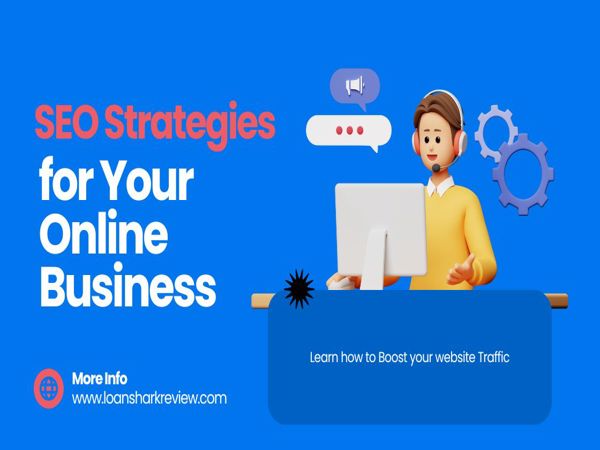If you’re looking to increase traffic to your online business, SEO (Search Engine Optimization) is essential. By implementing the right strategies, you can improve your website’s visibility on search engines like Google, driving more visitors and potential customers. Here’s a look at the top 10 SEO strategies that can help your business reach new heights in online visibility and engagement.
1. Conduct Keyword Research
Keywords are at the core of SEO. Start by identifying the keywords and phrases potential customers might use to find products or services in your niche.
Step-by-Step Solution:
- Use Tools: Tools like Google Keyword Planner, Ahrefs, and SEMrush can help you find relevant keywords.
- Focus on Long-Tail Keywords: These are specific phrases that attract a more targeted audience. For example, instead of “SEO,” use “SEO strategies for small businesses.”
Example:
For an online bakery, instead of just targeting “cakes,” try “custom cakes in New York” or “birthday cakes delivery.”
2. Optimize On-Page Elements
On-page optimization is essential for search engines to understand your content. Optimizing titles, meta descriptions, and headers can significantly improve your site’s SEO.
Step-by-Step Solution:
- Use Target Keywords in Titles and Headers: Incorporate primary keywords naturally in titles and H1 tags.
- Write Meta Descriptions: Each page should have a unique meta description, ideally between 150-160 characters.
Example:
For a blog on “Healthy Recipes,” the title could be “Healthy Recipes for Busy People | Easy, Quick, and Delicious.”
3. Optimize for Mobile
With more people browsing on mobile devices, it’s essential that your website is mobile-friendly. Google now uses mobile-first indexing, so sites that aren’t mobile-friendly could rank lower in search results.
Step-by-Step Solution:
- Test Mobile-Friendliness: Use Google’s Mobile-Friendly Test to identify any issues.
- Responsive Design: Ensure your site is designed to adapt to all screen sizes, ensuring a smooth user experience on mobile.
Example:
A responsive website for an e-commerce store allows customers to view products seamlessly, whether on a desktop or mobile device.
4. Improve Site Speed
Site speed directly impacts user experience and SEO. A slow site can drive users away, increasing your bounce rate.
Step-by-Step Solution:
- Use Tools Like Google PageSpeed Insights: This tool provides specific recommendations for improving your site speed.
- Optimize Images and Code: Compress images, remove unnecessary plugins, and minimize CSS and JavaScript files.
Example:
An image-heavy site, like an online portfolio, should have compressed images to ensure fast load times.
5. Create High-Quality Content
Content is still king in SEO. By producing valuable, relevant, and informative content, you can keep visitors on your site longer and increase engagement.
Step-by-Step Solution:
- Use Keywords Naturally: Avoid keyword stuffing, and make sure your content provides real value.
- Add Visuals and Subheadings: To make content engaging, include images, infographics, and videos where appropriate.
Example:
A digital marketing agency might create blog posts with detailed tutorials, case studies, and real-world examples.
6. Optimize for Local SEO
If your business has a physical location, local SEO can drive traffic to your website and encourage in-store visits.
Step-by-Step Solution:
- Claim Your Google My Business Listing: Ensure that your business information is accurate.
- Add Local Keywords: Include your city or area name in titles and content.
Example:
A coffee shop in Los Angeles might target “best coffee shop in LA” and ensure it appears on Google Maps.
7. Build Quality Backlinks
Backlinks from reputable sites can significantly improve your SEO. They indicate to search engines that your content is valuable and credible.
Step-by-Step Solution:
- Reach Out for Guest Posting: Write high-quality guest posts for reputable sites in your industry.
- Create Link-Worthy Content: Content like infographics, how-to guides, and research reports tend to get more backlinks.
Example:
A tech blog could create a research report on the latest tech trends, attracting backlinks from other industry blogs.
8. Use Internal Linking
Internal links connect different pages within your site, helping users navigate and encouraging them to explore more of your content. It also distributes link equity, which helps boost SEO.
Step-by-Step Solution:
- Link to Related Articles or Products: When creating new content, link to other pages or products on your site.
- Use Descriptive Anchor Texts: Make sure your links give an idea of what the reader will find.
Example:
In a blog post about SEO, linking to articles like “Top 5 Free SEO Tools” can keep users on your site longer.
9. Implement Schema Markup
Schema markup is a form of microdata that helps search engines understand your site’s content. Rich snippets, like reviews, star ratings, and FAQs, improve click-through rates.
Step-by-Step Solution:
- Use Google’s Structured Data Markup Helper: This tool makes it easy to implement schema markup.
- Implement Common Schemas: For online stores, Product Schema is essential; for blogs, Article Schema is beneficial.
Example:
Adding review schema for a product page can make the listing more attractive in search results by displaying a star rating.
10. Monitor and Analyze Performance
Tracking and analyzing your SEO efforts is crucial to refining your strategies. Regular monitoring helps you identify what works and what needs improvement.
Step-by-Step Solution:
- Use Google Analytics and Search Console: These tools help you understand where your traffic is coming from and which keywords are performing best.
- Adjust Based on Insights: If a particular blog post is driving significant traffic, consider creating similar content.
Example:
If an online clothing store notices that “summer dresses” performs well, they could create similar content around “winter coats” or “fall fashion.”
Conclusion
By following these 10 SEO strategies, you can improve your online business’s visibility, reach new audiences, and boost your site’s traffic. Remember, SEO is a long-term process, and the more consistent and committed you are, the better your results will be over time.

.jpg)








